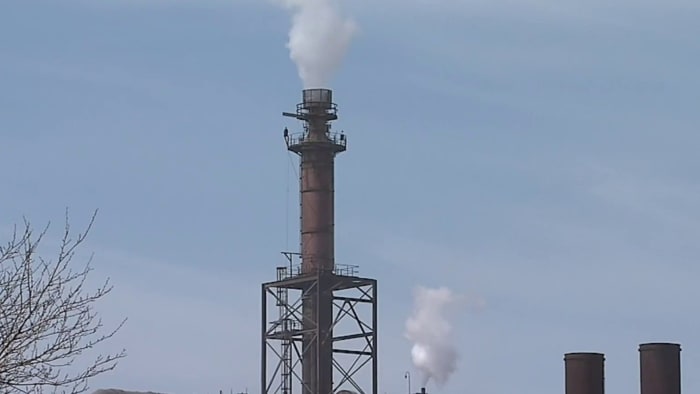How pollution can impact your lungs
How pollution can impact your lungs WJXT News4JAX


Poor Air Quality and Its Impact on Health

Poor air quality can take a toll on our lungs and overall health.
Dr. Maeve MacMurdo, a pulmonologist with Cleveland Clinic, explains why it’s important to pay attention to air quality alerts.
“People weren’t thinking about air quality for a long time. You may have seen an air quality alert and didn’t give it much thought,” MacMurdo said. “But people are now realizing more and more that poor air quality can impact our health.”
According to MacMurdo, poor air quality not only makes symptoms worse for those living with chronic lung diseases — but it can up your chances of developing something like asthma as well.
Air pollution may also increase a person’s risk of developing other conditions such as lung cancer, breast cancer and heart disease.
Sustainable Development Goals (SDGs)
- Goal 3: Good Health and Well-being
- Goal 11: Sustainable Cities and Communities
- Goal 13: Climate Action
Air Quality Monitoring
- You can keep tabs on the air quality in your area by using the U.S. Air Quality Index.
Precautions for Vulnerable Groups
Although air pollution can be harmful to anyone — children, older adults and those with certain chronic health conditions should take extra precautions when the air quality is poor.
MacMurdo recommends limiting your time outside when there’s an active air quality alert and trying to minimize indoor pollutants.
“If you have an indoor air purifier, a HEPA air purifier, those can really help to reduce the amount of air pollution that’s coming inside the home,” MacMurdo said. “Avoid doing things like burning candles or incense as well because that’s going to create indoor air pollution.”
When air quality is poor, MacMurdo also suggests staying away from activities like mowing the lawn to avoid creating more pollution.
SDGs, Targets, and Indicators
| SDGs | Targets | Indicators |
|---|---|---|
| SDG 3: Good Health and Well-being | 3.9 By 2030, substantially reduce the number of deaths and illnesses from hazardous chemicals and air, water, and soil pollution and contamination | Not mentioned in the article |
| SDG 11: Sustainable Cities and Communities | 11.6 By 2030, reduce the adverse per capita environmental impact of cities, including by paying special attention to air quality and municipal and other waste management | Not mentioned in the article |
| SDG 13: Climate Action | 13.2 Integrate climate change measures into national policies, strategies, and planning | Not mentioned in the article |
| SDG 15: Life on Land | 15.1 By 2020, ensure the conservation, restoration, and sustainable use of terrestrial and inland freshwater ecosystems and their services, in particular forests, wetlands, mountains, and drylands, in line with obligations under international agreements | Not mentioned in the article |
1. Which SDGs are addressed or connected to the issues highlighted in the article?
SDG 3: Good Health and Well-being
The article discusses the impact of poor air quality on our health, specifically mentioning how it can worsen symptoms for those with chronic lung diseases and increase the risk of developing conditions like asthma, lung cancer, breast cancer, and heart disease.
SDG 11: Sustainable Cities and Communities
The article emphasizes the importance of paying attention to air quality alerts and taking precautions to minimize indoor pollutants. This connects to the target of reducing the adverse per capita environmental impact of cities, including air quality management.
2. What specific targets under those SDGs can be identified based on the article’s content?
Target 3.9: By 2030, substantially reduce the number of deaths and illnesses from hazardous chemicals and air, water, and soil pollution and contamination
The article highlights the impact of poor air quality on health, indicating the need to reduce illnesses caused by air pollution.
Target 11.6: By 2030, reduce the adverse per capita environmental impact of cities, including by paying special attention to air quality and municipal and other waste management
The article emphasizes the importance of monitoring air quality and taking measures to minimize indoor pollutants, aligning with the target of reducing the adverse environmental impact of cities.
3. Are there any indicators mentioned or implied in the article that can be used to measure progress towards the identified targets?
No, the article does not mention or imply any specific indicators that can be used to measure progress towards the identified targets.
SDGs, Targets, and Indicators
| SDGs | Targets | Indicators |
|---|---|---|
| SDG 3: Good Health and Well-being | 3.9 By 2030, substantially reduce the number of deaths and illnesses from hazardous chemicals and air, water, and soil pollution and contamination | Not mentioned in the article |
| SDG 11: Sustainable Cities and Communities | 11.6 By 2030, reduce the adverse per capita environmental impact of cities, including by paying special attention to air quality and municipal and other waste management | Not mentioned in the article |
| SDG 13: Climate Action | 13.2 Integrate climate change measures into national policies, strategies, and planning | Not mentioned in the article |
| SDG 15: Life on Land | 15.1 By 2020, ensure the conservation, restoration, and sustainable use of terrestrial and inland freshwater ecosystems and their services, in particular forests, wetlands, mountains, and drylands, in line with obligations under international agreements | Not mentioned in the article |
Behold! This splendid article springs forth from the wellspring of knowledge, shaped by a wondrous proprietary AI technology that delved into a vast ocean of data, illuminating the path towards the Sustainable Development Goals. Remember that all rights are reserved by SDG Investors LLC, empowering us to champion progress together.
Source: news4jax.com

Join us, as fellow seekers of change, on a transformative journey at https://sdgtalks.ai/welcome, where you can become a member and actively contribute to shaping a brighter future.







